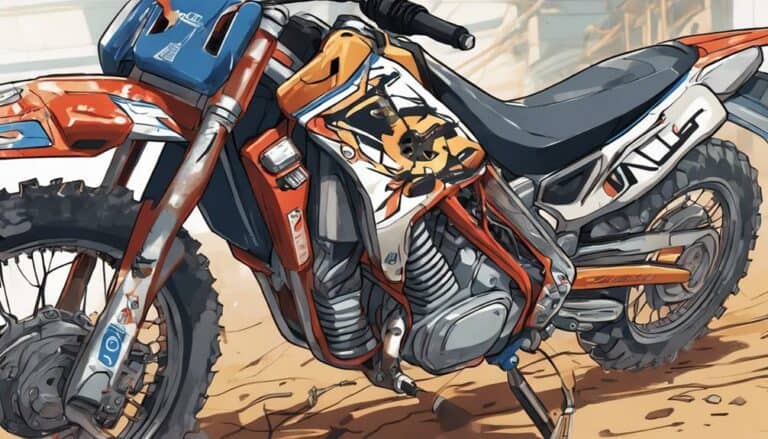When it comes to wiring a regulator rectifier to your dirt bike, remember the old saying, 'Measure twice, cut once.'
Ensuring a reliable electrical system is essential for the best performance of your bike. Understanding the correct connections and following precise steps will prevent potential damage and keep your ride running smoothly.
So, let's get started on this essential aspect of maintaining your dirt bike's electrical system.
Key Takeaways
- Properly mount the regulator rectifier for efficient heat regulation and performance.
- Understand the wiring diagram and color-coding for accurate connections.
- Connect the regulator rectifier following correct polarity and insulation guidelines.
- Test stator output, battery voltage, and regulator rectifier for proper functionality and maintenance.
Required Tools and Materials
You'll need wire cutters, wire strippers, and a soldering iron to wire a regulator rectifier to your dirt bike. When undertaking this task, making sure you have the appropriate tools and materials is important for a successful installation.
Alongside these tools, guarantee you have the right wires, connectors, and heat shrink tubing to create a secure and reliable connection. Understanding the wiring diagram of your dirt bike and the regulator rectifier is essential to guarantee correct installation.
This comprehension will allow you to follow the color-coding of wires from the regulator rectifier and match them with the corresponding wires on the dirt bike's electrical system accurately. It's essential to properly insulate and secure all connections to prevent short circuits or electrical malfunctions during the operation of your dirt bike.
Locating the Regulator Rectifier
To locate the regulator rectifier on your dirt bike, examine the area near the battery or other electrical components for a component featuring cooling fins designed for heat dissipation. Some bikes may have the regulator rectifier integrated into the electrical system, which can make it harder to spot visually. If you're having trouble identifying it, consult your bike's manual or seek guidance from online resources for sure. Proper placement and secure mounting of the regulator rectifier are important for best performance and heat regulation on your dirt bike.
| Regulator Rectifier Location | Description |
|---|---|
| Near Battery | Look for a component with cooling fins attached to the frame or other metal parts. |
| Electrical Components Area | Check for a component designed for heat dissipation to ensure efficient operation. |
| Integrated Systems | Some bikes may have the regulator rectifier integrated into the electrical system. |
| Consult Resources | Refer to the bike's manual or online guides for help in locating the regulator rectifier. |
Understanding the Wiring Diagram
Understanding the wiring diagram for the regulator rectifier on your dirt bike is essential for proper installation and troubleshooting. When looking at the diagram, make sure to pay attention to the connection points for the regulator, stator, battery, and other electrical components.
The color-coding of wires is vital, as it helps in correctly identifying and connecting the wires according to their functions. Different dirt bike models may have variations in their wiring setup, so always refer to the specific manual or guide for accurate instructions.
The diagram will indicate which wires carry AC voltage from the stator and which ones carry DC voltage to the battery and other parts of the electrical system. By following the wiring diagram diligently, you make sure that the regulator rectifier functions as intended, regulating voltage output and safeguarding the electrical system of your dirt bike.
Pay close attention to details and make sure each connection is made accurately to prevent any issues during operation.
Connecting the Regulator Rectifier
When linking the regulator rectifier to your dirt bike, make sure that you match the positive and negative terminals correctly for proper functionality. Here are the steps to guarantee a successful connection:
- Secure Connections: Use quality connectors and soldering techniques to create reliable links between the regulator rectifier and the dirt bike's electrical system.
- Follow Manufacturer's Instructions: Adhere to the manufacturer's guidelines regarding wire colors and configurations to prevent any damage to the regulator rectifier during the connection process.
- Insulate Connections: Apply heat shrink tubing or electrical tape to insulate all connections thoroughly. This insulation will safeguard the connections from moisture and vibrations, guaranteeing longevity and reliability.
- Verify Functionality: After completing the connection, test the regulator rectifier to confirm that the charging system is operating correctly on your dirt bike.
Testing the Electrical System
After confirming the proper connection of the regulator rectifier to your dirt bike, the next step is to use a multimeter to test the voltage output of the stator within the specified range. Start by setting your multimeter to AC voltage mode and connecting the probes to the stator leads. The voltage reading should fall within the manufacturer's recommended range, typically between 20 to 50 volts, depending on your bike's specifications.
Next, check the continuity between the stator leads and the regulator rectifier to verify proper connections. A lack of continuity could indicate a faulty connection that needs to be addressed. Proceed by testing the battery voltage when the bike is running to confirm that the charging system is functioning correctly. Make sure that the battery voltage increases when the engine is revved, indicating that the charging system is operational.
Inspect the wiring harness for any signs of damage or corrosion that could adversely affect the electrical system's performance. Finally, evaluate the regulator rectifier's grounding to ensure a solid connection for efficient operation. Any loose or poor grounding can lead to electrical issues, so it's important to address them before testing something else.
Conclusion
To sum up, wiring a regulator rectifier to a dirt bike is like giving your electrical system a reliable guardian angel. By following proper installation procedures and connecting the components securely, you make certain that your bike's power supply is regulated and efficient.
Just as a skilled conductor directs an orchestra, the regulator rectifier orchestrates the flow of electricity, keeping your dirt bike running smoothly and reliably.

